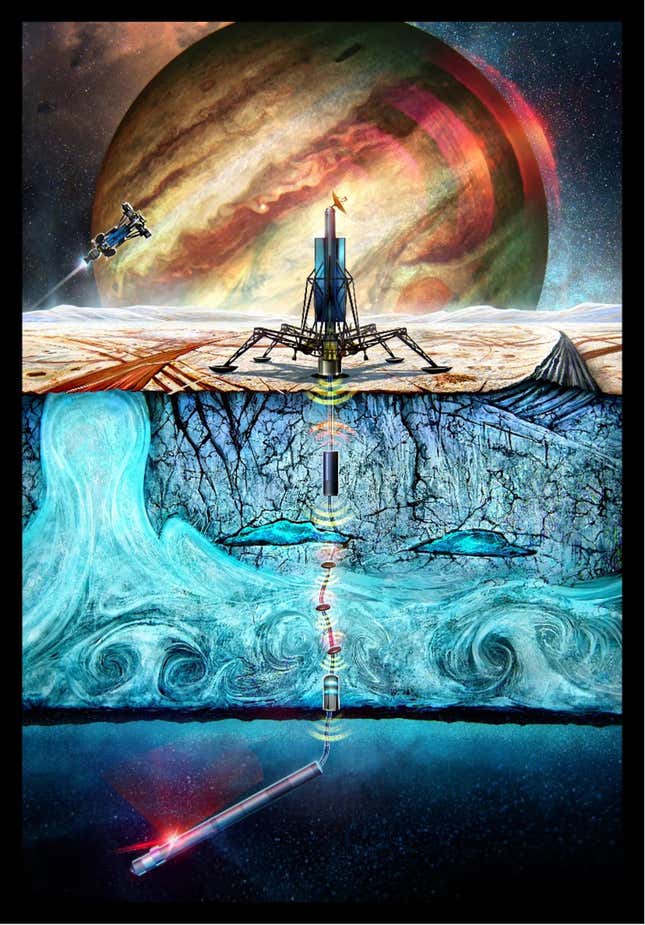Astrobiologists suspect there might be alien life simply out of attain in our photo voltaic system, in oceans hidden beneath icy crusts on moons circling Jupiter and Saturn. However not like the floor of Mars, which will be explored by rovers and landers, these mysterious oceans are at the moment inaccessible to us. In an effort to alter that, researchers convened this 12 months to design a novel mission that would lastly reveal what’s in these distant water worlds.
The proposed probe, known as a cryobot, is a cylindrical robotic that may be able to heating up ice to drill via it, permitting the bot to entry the liquid water ocean beneath. The workshop, held in February on the California Institute of Expertise, introduced collectively over 40 researchers to mature the technological idea. The members explored the ability, thermal, mobility, and communication programs crucial for such a mission, as NASA described in a recent article.
Scientists take critically the concept that some type of life exists off Earth, and area observatories together with the Webb Space Telescope and ultimately the Habitable Worlds Observatory are designed to collect data on exoplanets the place alien life may kind. These worlds, although, are a lot too distant for us to discover immediately. As a substitute, our greatest hope is to look the place liquid water probably exists in our photo voltaic system.

The idea would work like this: A lander would alight on a frozen moon and deploy a cylindrical probe to interrupt via the icy floor utilizing hot-water drilling. The cryobot would have a roughly 10 kilowatt nuclear energy system that may be protected inside a construction that shields it from the excessive stress of the deep ocean.
A thermal administration system would maintain inner temperatures at a protected stage and correctly distribute the warmth all through the system. A water jetting and slicing system could be included within the gadget to permit the cryobot to clear rocks, particulate matter, and salt encased within the ice.
The workshop members concluded {that a} demonstration of hazard mitigation programs is a excessive precedence for future work on the idea.
Additionally they decided that any cryobot deployed on a moon would want a communication hyperlink that permits it to transmit info to a floor lander, which in flip would relay that information to Earth. Whereas fiber optic cables are an trade commonplace, NASA defined, actions within the ice shelf may lower off the connection between the lander and the probe, which might be kilometers beneath the ice. Wi-fi communication strategies are on the desk, together with radio, acoustic, and magnetic transceivers.
Jupiter’s moon Europa and Saturn’s moon Enceladus are of explicit curiosity for astrobiologists. NASA and ESA have committed missions to exploring Europa and developed a mission concept for visiting Enceladus. NASA’s Europa Clipper is predicted to launch in October 2024, and its observations will inform the best design for a cryobot probe, which might want to breach the moon’s frozen floor after which relay information from the ocean beneath. The Enceladus Orbilander would orbit after which land on the Saturnian moon, searching for indicators that the subsurface ocean may include life. Earlier this 12 months, a workforce of scientists found evidence that phosphorus, a key ingredient for all times as we all know it, was being belched up by Enceladus, whose water vapor plumes can be over 6,000 miles long.
The current workshop members concluded that the mission idea “stays possible, scientifically compelling, and essentially the most believable near-term solution to immediately seek for life in situ on an ocean world,” based on a NASA.
It is going to be years earlier than we see a probe contact down on certainly one of these icy moons, however we’re getting a lot nearer to really exploring an alien ocean.
Extra: Evidence of Life Could Exist Just Beneath Europa’s Icy Surface
Trending Merchandise















